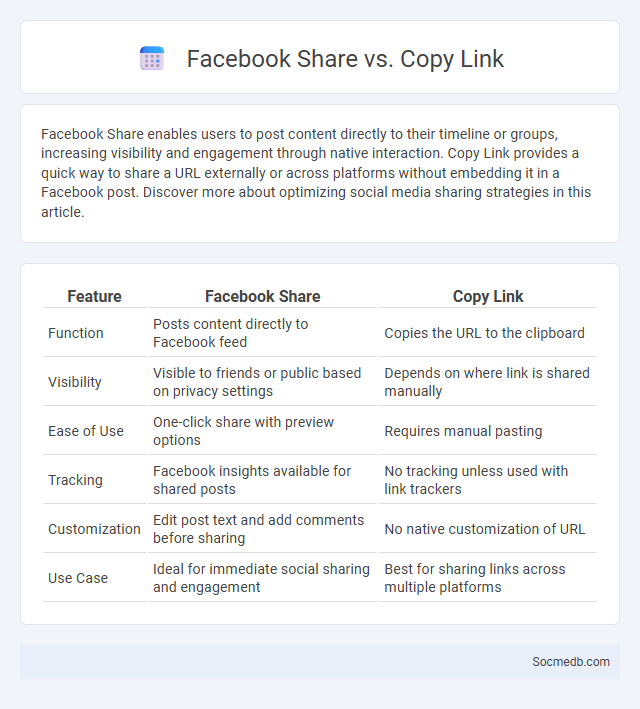
Photo illustration: Facebook Share vs Copy Link
Facebook Share enables users to post content directly to their timeline or groups, increasing visibility and engagement through native interaction. Copy Link provides a quick way to share a URL externally or across platforms without embedding it in a Facebook post. Discover more about optimizing social media sharing strategies in this article.
Table of Comparison
| Feature | Facebook Share | Copy Link |
|---|---|---|
| Function | Posts content directly to Facebook feed | Copies the URL to the clipboard |
| Visibility | Visible to friends or public based on privacy settings | Depends on where link is shared manually |
| Ease of Use | One-click share with preview options | Requires manual pasting |
| Tracking | Facebook insights available for shared posts | No tracking unless used with link trackers |
| Customization | Edit post text and add comments before sharing | No native customization of URL |
| Use Case | Ideal for immediate social sharing and engagement | Best for sharing links across multiple platforms |
Understanding Facebook Sharing Options
Understanding Facebook sharing options allows you to control the audience for your posts, ensuring your content reaches the right people while maintaining privacy. You can choose between Public, Friends, Friends except..., Specific friends, or Only me, tailoring sharing preferences based on the sensitivity of your information. Mastering these settings enhances your social media experience and protects your online presence effectively.
What is “Facebook Share”?
Facebook Share is a social media feature that allows you to quickly post content from websites, articles, or videos directly to your Facebook timeline, enhancing your online engagement. This tool streamlines the process of sharing valuable information with your network, increasing visibility and interaction on your profile. Using Facebook Share boosts content distribution and helps grow your digital presence efficiently.
What Does “Copy Link” on Facebook Do?
The "Copy Link" feature on Facebook allows you to instantly copy the URL of a specific post, photo, video, or page to your clipboard, enabling easy sharing outside the platform. This link directs anyone with the URL straight to the selected content, even if they aren't your Facebook friends, increasing accessibility and engagement. Using this tool enhances your ability to distribute important posts with precision across other social media networks, emails, or messages.
Exploring the “Share” Button Variations
The "Share" button on social media platforms comes in various forms, including direct messaging, posting to your timeline, and sharing to groups or stories, each designed to enhance content distribution and engagement. Understanding how these variations function can help you amplify your reach and tailor your content sharing strategy effectively. Leveraging the right share option ensures that your message resonates with the intended audience, maximizing visibility and interaction.
Facebook Share vs Copy Link: Key Differences
Facebook Share allows you to post content directly to your timeline or friends' feeds, increasing visibility and engagement through native platform features like reactions and comments. Copy Link simply copies the URL of a post or page, enabling you to share it externally or within other apps without triggering Facebook's interactive tools. Understanding these differences helps optimize your social media strategy by leveraging Facebook Share for in-platform interaction and Copy Link for broader content distribution.
When to Use Facebook Share vs Copy Link
Use Facebook Share to directly promote content within the Facebook ecosystem, enhancing visibility through user engagement, comments, and likes. Opt for Copy Link when sharing content across multiple platforms or messaging apps outside Facebook, maintaining link integrity and broad accessibility. Choosing between Share and Copy Link depends on the target audience's platform preference and the desired interaction type.
Pros and Cons of Facebook Sharing Methods
Facebook sharing methods enable users to quickly distribute content to a broad audience, enhancing social connectivity and engagement through features like posts, stories, and groups. However, these methods raise privacy concerns due to data exposure risks and algorithmic biases that may limit content visibility or create echo chambers. Effective use of Facebook sharing requires balancing personal information protection with the platform's powerful networking and communication capabilities.
Impact on Privacy and Audience Reach
Social media platforms collect vast amounts of personal data, raising significant privacy concerns due to potential misuse and data breaches. Enhanced targeting algorithms enable businesses and influencers to reach highly specific audiences, increasing engagement and marketing efficiency. However, this precise audience reach often comes at the cost of reduced user privacy and heightened exposure to surveillance.
Best Practices for Sharing Content Effectively
Maximize your social media impact by tailoring content to each platform's unique audience and format, ensuring higher engagement rates. Use high-quality visuals, concise captions, and relevant hashtags to increase visibility and encourage interaction. Consistently post during peak activity times and respond promptly to comments to foster community and trust with your followers.
Choosing the Right Facebook Sharing Option
Selecting the appropriate Facebook sharing option enhances content visibility and engagement by targeting specific audiences such as friends, public followers, or custom groups. Utilizing privacy settings like "Friends except..." and "Specific friends" allows for tailored sharing, ensuring sensitive information reaches intended viewers only. Optimizing post reach involves evaluating the content type and desired interaction to decide between sharing as a personal timeline post, group post, or page update.
 socmedb.com
socmedb.com